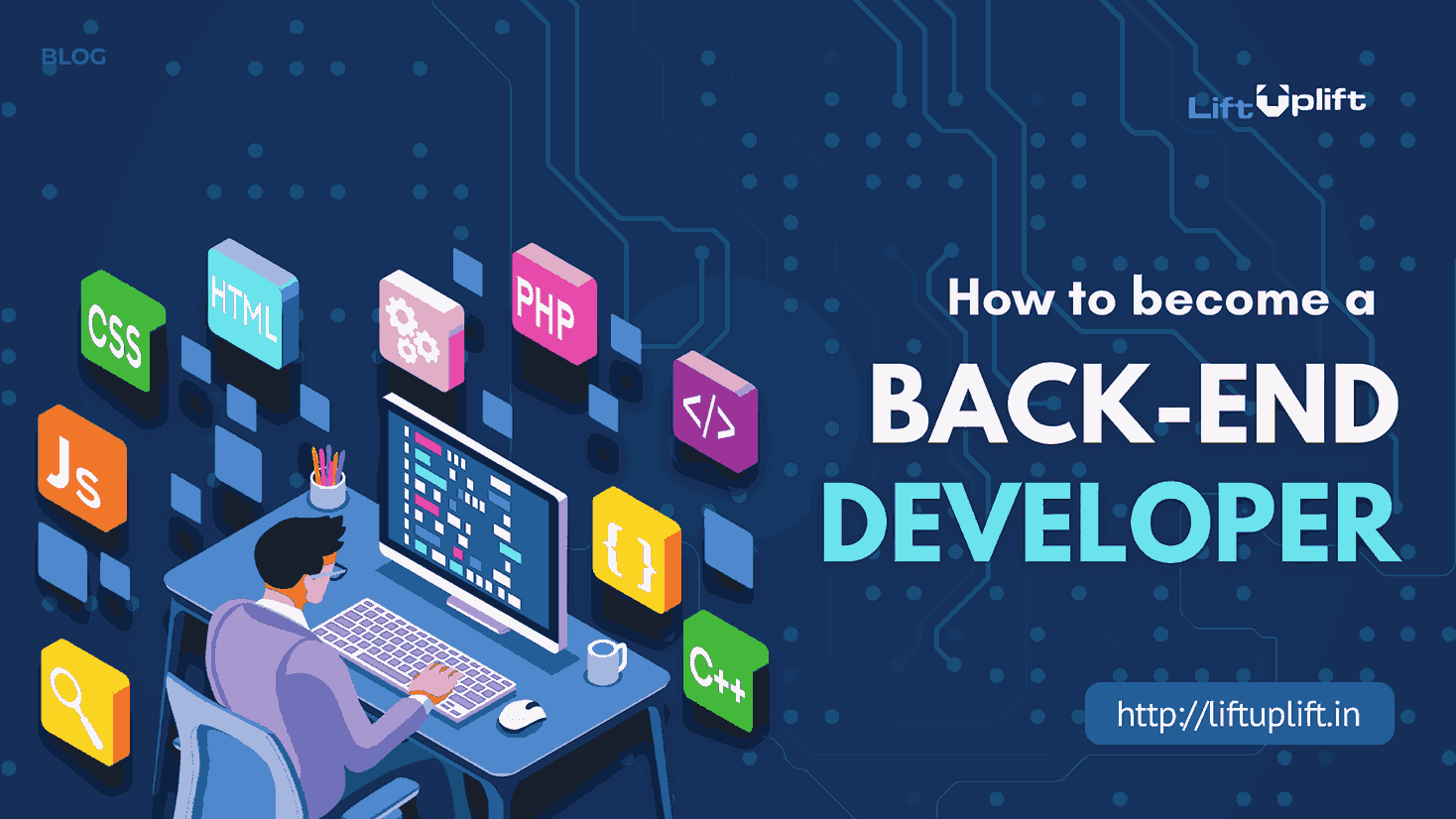Ever wondered how your favourite apps or sites work behind the scenes? Whether you buy something online or book a flight, it’s all powered by Back End Developers. He’s the backbone of every web application, so everything works smoothly behind the scenes. Want to get into tech? Well, the key to a rewarding, fulfilling, and highly sought-after career in India might be learning how to become a backend developer.
So, are you ready to begin this exciting journey? Let’s get started with becoming a successful backend developer!
What does a Backend Developer do?
A back-end developer is responsible for how the server side of web applications is developed and maintained. At the same time that a front-end developer is responsible for what users see, a back-end developer takes care of everything else that makes an app run smoothly. Here’s what they do:
- Managing Databases: Handling storage, retrieval, and organization of data
- Server-Side Logic: Processing user requests, ensuring efficient communication with the database.
- API Integration: It is the integration of two different systems and applications that can ensure an easy flow of data.
- Security & Performance: Installing security measures so that the application will still function well with huge amounts of data.
Quite simply, a back-end developer is instrumental in providing a web application with effective functioning and reliability.
But before we go into that, let’s take a closer look at what exactly is a backend developer and why his job is important.
Who is a Backend Developer?
A back-end developer is a type of specialized programmer who handles the “invisible” parts of a website or app: database, server, and application logic. The person responsible for everything to function behind the scenes, processing transactions and communication between the front-end and back-end systems.
Just think of a back-end developer as the person ensuring that every click made on a website makes the right change; perhaps data is stored, payment is processed, or the information you need is retrieved.
Step-by-Step Guide on How to Become a Backend Developer?
If you are ready to learn How to become a Back End Developer, follow these structured steps to build a strong foundation:
Step 1: Learn a Programming Language
Master one or more server-side programming languages such as Python, Java, Ruby, or PHP. Python is user-friendly and great for beginners, while Java is widely used in enterprise applications.
Step 2: Understand Databases:
DATA management is one of the major tasks of any backend developer. Learning the SQL databases such as MySQL or PostgreSQL, and NoSQL databases like MongoDB will be further helpful in managing and querying data.
Step 3: Master Back End Frameworks:
You can speed up the development process by learning popular frameworks, like Django in Python, Spring in Java, Express in Node.js, and Laravel in PHP. These tools have predefined structures that greatly ease the coding work.
Step 4: Know API Development:
With APIs, also known as Application Programming Interfaces, different software systems can communicate with one another. Get knowledge of RESTful APIs and GraphQL, and learn about developing dynamic and data-driven applications.
Step 5: Servers and Hosting:
Be familiar with working servers and hosting an application. Knowing cloud services such as AWS, Google Cloud, or Azure is important to manage modern web applications.
Step 6: Build Real-World Projects:
Practical experience counts. You can begin with a simple blog, a web-based e-commerce site or a task manager for getting much hands-on practice. They are bound to showcase to future employers.
Step 7: Enrol for a Back End Developer Course:
Take up courses from platforms that offer back-end development, such as Udemy, Coursera, or edX. Courses will keep you focused and provide valuable hands-on experience.
Learning Backend Development
To learn backend development, follow this comprehensive approach:
- Free Resources: W3Schools, freeCodeCamp, and MDN Web Docs have tutorials about backend technologies in detail.
- Enroll in a Course: A formal course in backend development will be instrumental in taking you from being a newbie to a guru. Most courses on Udemy, Codecademy, and Coursera include project-based learning.
- Join developer communities: From GitHub, Stack Overflow, and Reddit to similar platforms, that will get you connected with fellow developers, open-source projects that you can contribute to, and answers to your technical challenges.
- Practice, Practice, Practice: Use coding challenge platforms such as LeetCode, HackerRank, and Codewars to hone problem solving skills.
With this roadmap, you’ll be all set to gain mastery over back-end development. Next, we’ll be discussing the key skills of a successful backend developer.
Skills and Qualifications to Be a Backend Developer
The following are the must-have skills to be a successful backend developer: Skills for becoming adept as a backend developer are as follows:
- Programming languages: proficiency in Java, Python, Ruby, or PHP.
- Database Management: Knowledge of SQL and NoSQL databases.
- Frameworks: mastery of frameworks like Django, Spring, Flask, or Laravel.
- API Development: Familiarity with REST and GraphQL.
- Version Control: Git familiarity for managing and collaborating code.
- Server Management: Aware of the cloud services like AWS, Heroku, or DigitalOcean.
- Problem Solving Skills: Can debug and optimise the code professionally.
Having equipped you with these skills, let’s look at the backend development requirements that can get you your first job.
Requirements to be a Backend Developer
These are the back-end development requirements to start your career:
- Education Background: A Computer Science degree is great, but most backend developers learn by self-teaching or coding camps.
- Practical Experience: Employers view experience. Work on your projects and make contributions to open-source platforms.
- Certifications: Take certified backend developer courses to give credibility to your resume.
- Portfolio: Host actual real-world projects in your portfolio, which will prove critical in any application for backend developer jobs for freshers.
- Tools Familiarity: Understand the tools that a backend developer might use, which range from Docker to Jenkins, and even cloud services.
Having these requirements in mind, let’s now dive into a detailed roadmap for backend developer roles.
Roadmap for Backend Developer
Following is a structured roadmap that helps backend developers be successful.
- Start with the Basics: You need to start with either Python or Java for foundational programming.
- Move to Databases and Servers: Understand databases, and learn to manage server-side logic.
- Build Projects: You will make real-world applications to improve your skills as well as your portfolio.
- Internships: Getting real-world experience through internships will help you to get into the role of a full-time developer.
- Always updated: the technology world is one that keeps changing daily, with you having to learn new tools, frameworks, and languages.
Having a roadmap lets us now look at the job market and a variety of career options for backend developer jobs for freshers.
Career Opportunities for Backend Developers
The tech industry in India is booming, and a skilled backend developer is needed everywhere. Opportunities are plentiful for startups and multinationals if that’s the way you want to go. Good entry-level positions involve titles like Junior Back End Developer, Backend Engineer, or Full Stack Developer, offering many entry points into this career.
| Job Title | Average Salary (₹) | Salary Range (₹) |
| Entry-Level Backend Developer | 3,50,000 | 90,000 – 11,20,000 |
| Backend Developer | 8,80,000 | 1,50,000 – 18,00,000 |
| Senior Backend Developer | 18,00,000 | 4,10,000 – 35,00,000 |
| Backend Engineer | 28,20,000 | 16,80,000 – 1,17,60,000 |
Many companies have open positions for hiring freshers as backend developers so that you can join right after you gain the required skills. Also, once you go up your career ladder, you can take on the roles of a Lead Developer or DevOps Engineer, and expand your expertise as well as potential income.
Well, let’s summarize what we learned and what the next steps for becoming a backend developer are.
Conclusion
Becoming a back-end developer is very rewarding and currently an actively sought-after career path. With the increasingly high demands of web applications and cloud-based services, mastering back-end technologies opens doors to exciting opportunities. Following these steps in the guide will adequately prepare you to begin this journey. Whether it’s learning a new programming language, building your first project, or applying for internships, every step counts towards becoming a successful back-end developer.
So are you ready to start your journey and explore all the endless possibilities in back-end development?
Frequently Asked Questions
What is a Backend Developer?
A person responsible for server-side development, which will include the management of databases, and APIs, as well as the smooth functionality of web applications.
How can one become a Backend Developer?
You can become a Back End Developer if you learn programming languages, understand databases, and master frameworks, and have hands-on experience through projects.
What skills make a successful Backend Developer?
As a result, the individual skills include proficiency with server-side language, database management, a role in the development of APIs, critical problem-solving, and knowledge of cloud services.




